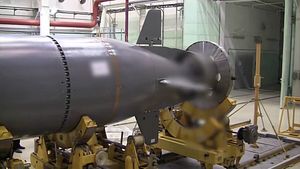Russia’s newest underwater weapon, a nuclear-capable underwater drone alternatively referred to as an unmanned underwater vehicle (UUV), autonomous underwater vehicle (AUV), or simply an intercontinental-range, nuclear autonomous torpedo, designated “Poseidon”, has successfully completed a “key” stage of sea trials, according to Russian President Vladimir Putin.
“A few days ago you informed be about completion of the key stage of trials of the unmanned multipurpose and strategic underwater combat vehicle Poseidon,” Putin was quoted as saying to Defense Minister Sergei Shoigu during a meeting with the heads of the Russian Foreign Ministry and Defense Ministry in Moscow on February 2. Neither the Russian president nor the Russian defense minister revealed additional information about the Poseidon and its ongoing sea trials. However, according to an anonymous defense industry source cited by TASS news agency, “During the at-sea trials of the unmanned vehicle’s power unit, the previously declared specifications of its unlimited range of use and speed of over 200 kmph were confirmed.”
As I reported previously, the current tests, which purportedly commenced in December 2018, are likely part of experimental design work rather than full-fledged sea trials. Russia’s Ministry of Defense (MoD) already announced in July 2018 that sea trials, primarily focused on the Poseidon’s guidance system and underwater operations in autonomous mode, were under way.
The Poseidon, also known under Ocean Multipurpose System Status-6 or “Kanyon” by the U.S. intelligence community, “is a new intercontinental, nuclear armed, nuclear-powered, undersea autonomous torpedo,” according to the 2018 U.S. Nuclear Posture Review. Based on a 2015 classified Russian presentation slide, accidentally or deliberately broadcasted in a video clip on Russian state-run television station, the Poseidon can be fitted with a thermonuclear warhead with a layer of cobalt-59 yielding 100 megatons. However, more recent Russian reports cite a two-megaton warhead.
The Russian Navy is expected to deploy over 30 Poseidon UUVs once the weapon system is declared operational and cleared user trials, a Russian defense industry source revealed earlier this year. The Poseidon is listed in Russia’s state armament program for 2018-2027 and the first UUVs are expected to be delivered to the Russian military in the late 2020s.
The Poseidon will probably be carried by Project 09852 submarines – based on the 949A Oscar II-class nuclear-powered guided missile submarine —or Project 09851 subs — reportedly a downsized variant of the Borei-class of nuclear-powered ballistic missile submarines — two of which were laid down in December 2012 and July 2014 respectively at the Sevmash shipyard in Severodvinsk, a port city on Russia’s White Sea.
As I noted previously:
The UUV is being designed a weapon of last resort to strengthen Russia’s nuclear deterrence posture vis-à-vis the United States and NATO. Torpedoes equipped with a nuclear propulsion system and fitted with a nuclear warhead for use over long distances were first conceived in the Soviet Union back in the 1950s but were considered impractical and unreliable at the time.
There are still questions whether Russia will be capable of building a reliable miniaturized nuclear reactor for the UUV.
Notably, it remains unclear whether the Poseidon serves only as a nuclear-warhead delivery platform or could be used for other purposes including intelligence, surveillance, and reconnaissance (ISR) missions.
































